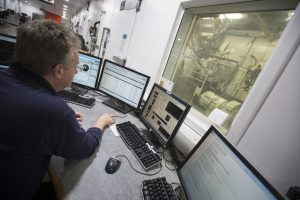Engineering the future
Engineering the future 1 2

On 8 September 2017, Perkins Engines held a press day showcasing their handling the implementation of EU Stage V. Never heard of it? Not many people have – but they should. At first sight a rather arcane set of emissions regulations relating to off-highway machines may seem somewhat dull. Further exploration of them reveals not only the astonishing progress that has been made in making engines cleaner, but also points to a vision of a greener future in which – perhaps surprisingly – the diesel engine turns out to be one of the good guys. Toby Venables investigates.
When it comes to car exhaust emissions, it’s fair to say that we hold car manufacturers in fairly low regard. At best, it seems, they are doing the minimum to cut emissions. At worst, actually cheating the system. And we all know that cars with engines that burn petrol are terrible polluters, that diesels are even worse, and that one day all these will be replaced by clean, green electric vehicles. Right?
Well, not quite. But we can certainly be excused for thinking so. In 2015, it emerged that Volkswagen diesel cars on sale in the US had what is called a ‘defeat device’ – a piece of software that detects when the engine is being tested for emissions and changes performance to improve results. VW admitted to cheating the tests, and the subsequent fallout worldwide – including lawsuits and vehicle recalls – has hardly been out of the news since. If you’ve heard anything at all about diesel engines in the mainstream press in the last two years, it’s likely to have been fairly damning.
But now for the good news.
Car manufacturers, of course, are not the sole users of diesel engines. In fact, they’re not necessarily even the main one. When we look at off-highway machines – everything from tractors to excavators to specialist mining equipment – diesel engines, of the kind built at Perkins Engines in Peterborough, dominate the scene, and you might be surprised at just how far things have progressed in the past couple of decades.
“Over the last 20 years we have become around 120 times cleaner”
Duncan Riding is Business Development Manager at Perkins but an engineer by training, as the letters after his name attest (BSc CEng FIMechE). ‘Over the last 20 years – which pretty much covers the duration of the EU emissions regulations for off-highway machines, from there being no regulations to where we are now with Stage V – we have become around 120 times cleaner,’ he says. ‘To put that further in perspective, an engine from 20 years ago would produce in a couple of months what an engine today would take 20 years to produce from its tailpipe.’ In his talk to the invited audience, Duncan represents the particulate matter coming from the tailpipe – 6kg in total – as bags of service station charcoal. Later, on a tour of the incredibly high-tech testing facilities at Perkins, we’re also shown two filters – one from an unregulated diesel engine, one from the latest generation of engines, both of which have been on test for the same number of hours. The example from the unregulated engine is pitch black. The later example has no visible discolouration whatsoever. It’s hard to imagine a more graphic demonstration – literally the difference between black and white.
‘It is very significant what has taken place,’ continues Duncan. ‘Some of it is inside the engine – fuel systems and combustion systems have developed very dramatically and are almost unrecognisable in terms of how we go about burning fuel.’ Engines 20 years ago, he explains, typically injected fuel into the cylinders at a pressure of 250 bar – or 250 times atmospheric pressure. That has evolved, in the latest fuel systems, to an incredible 2,000 bar injection pressure. ‘That causes the fuel to atomise into smaller droplets and burn more completely, reducing particulate emissions. But there’s only so much the engine can do on its own, so then you also have to have an after-engine treatment system, such as diesel particulate filters for controlling smoke, and using SCR – Selective Catalytic Reduction – to reduce the amount of NOx [nitrogen oxide]. You can’t do that just within the engine system. But all of those together have dramatically reduced emissions.’
 TESTING, TESTING…
TESTING, TESTING…
The Peterborough facility where Perkins build their engines is not just a factory. It is also a centre for research and development, and a place where engines are put through their paces on a vast array of test beds, in all possible conditions – including extreme altitudes, working angles and temperatures. It’s here that Perkins’ engines have been prepared not just to meet the emissions requirements of Stage V, but to exceed them. It’s also where they ensure that their engines live up to the company’s formidable reputation for reliability. The company has been building such engines since 1932, but this is a tough challenge, with parameters and demands that are continually changing. Yet it’s a challenge to which this local company and global leader has continued to rise. That’s the real story – if only it was one we got to hear in the news.
Professor Colin Garner, from Loughborough University and guest speaker at the Perkins Stage V event, picks up the point. ‘The fact is, the engine-out emissions on either a Stage V off-highway vehicle or a Euro 6 on-highway vehicle [the equivalent regulations for road vehicles] are very low nowadays, and the after treatment gets it down extremely low. So, it is actually very clean. If people still think they’re dirty – probably because they see an old, smoky diesel on the road – then we just have to convince them with the data.’ As an engineer, Colin is clearly concerned that key issues are not being properly discussed or understood simply because they are not properly represented. One particular frustration for Colin is poor media coverage of the proposed alternatives – batteries and electric vehicles (about which, more later…).
One perception is that manufacturers approach emissions testing with reluctance. You only have to tour around Perkins’ testing facilities, however, to see there is no apparent reluctance on their part. The commitment, in terms of investment and approach, is total. ‘Perkins was influential in the development of off-highway emissions regulations when they first started,’ says Duncan. ‘So, we were part of the decision that those regulations were needed back before Stage I. But everybody is in the same place. These things haven’t been imposed on the UK or on Perkins – it’s more that we are all aware that we need to do it.’
The tests themselves have also been refined and toughened up over the past couple of decades, as Duncan explains. ‘When we first tested emission in off-highway engines, it was a constant speed and load. Clearly this doesn’t represent real-world use, where engine speed and load are changing all the time. So then, they added the transient emissions cycle, which much better represents the real-world use of a machine. Also, those early tests were under standard temperatures and pressures. Well, at altitude your air density is lower and therefore your engine could develop more smoke because less air is going in. So now you have to demonstrate emissions compliance up to a mile in altitude, and at a range of ambient temperatures. That makes it far more representative of real-world use. In Europe there’s very little likelihood of those machines working above a mile in altitude – the Alps and maybe the Pyrenees and that’s about it – but if you go to Denver, that’s at an altitude of a mile to begin with!’
And, of course, Perkins engines do go to Denver. In fact, there aren’t many places they don’t go, or many conditions they don’t operate in. ‘For about ten years now, we’ve been taking machine equipment to Sweden to do winter testing, because the winters aren’t cold enough in the UK. One of the primary challenges is starting. We develop the engines so they will cold start down to –20˚C without any change to what we offer, off the shelf. As soon as you go below that you need a lighter oil, and we also look at other such things as having jacket water heaters. But we are talking to people who have the need to start and operate machines down to –40˚C. In Sweden, everybody has a jacket water heater on their car engine and in winter everyone plugs it in overnight. Because it’s adjacent to the house, you have the availability of power. But an off-highway machine may well be stuck in the middle of nowhere without a power source, so the ability to cold start under those conditions is a real challenge.’
They also have to consider machines working in very high ambient temperatures. ‘We are signing off machine equipment to work in ambient temperatures of 50˚C – and generally when we talk about temperatures we mean temperatures in the shade. So it’s a very wide range of use.’
Within all these conditions, the engines need not only to function, but to remain emissions compliant – and it doesn’t end there, either. ‘There is also a DF test,’ explains Duncan, ‘or “deterioration factor” test, which means that you have to show that the emissions will be under the required level of control over the life of the engine.’ It’s perhaps a cliché to say Perkins go the extra mile, but here it is literally true – quite a few extra miles, in fact. ‘It’s very tough to know what is going to happen with an engine after it’s been running for, say, over 10,000 hours, and to have confidence in the reliability of emissions controls, but we saw through telematics monitoring that one of our four cylinder, 4.4 litre engines had hit 11,000 hours, so we whipped that engine out and put a replacement in, then brought the engine back to Peterborough and ran it through all the standard testing.’
They found it was still emissions compliant. They stripped it down to check it over, and ‘apart from being a bit grubby from where it had been in the machine, in terms of performance it was still fully in control after 11,000 hours’. To put those hours in perspective, consider an average speed of 50mph in your car. Now multiply that by 11,000 hours operation. That equates to 550,000 miles – a very long life for a car. ‘The emissions regulations are a lot more than just what’s coming out of the tailpipe during a test…’ says Duncan. ‘But the engines are far more complex now, with electronic systems and far greater demands put upon them. We need high confidence that when we hand over an engine system to a customer that it will work in their machine and be reliable.’
So, what is actually meant by ‘emissions’ anyway? The key undesirable elements coming out of an unregulated diesel exhaust include nitrogen oxides (NOx), carbon monoxide (CO), the greenhouse gas carbon dioxide (CO2), and ‘particulates’ – principally soot (unburned carbon) with various other particles, such as sulphates and silicates. These gases are poisonous, and the particulates are contributing factors in a whole range of serious health conditions, including cancer.
Scary as this sounds, its these that are now being controlled in the new engines (Stage V even specifically limits the number of larger, more hazardous particles) and by aftertreatment systems (to remove NOx, for example, which is now being achieved with 95% effectiveness). But always there are certain fundamentals of chemistry that need to be overcome, and it is a two-pronged assault. ‘Perfect combustion of hydrocarbon fuels gives you CO2,’ explains Duncan, ‘so if you’re going to be dependent on them, then that’s the dark side of that. The other element is that if you want the benefit of the high energy, hydrocarbon fuels, you create – or created, if you go back to the time before emissions regulations were introduced – local pollutants. Now, those regulations are controlling them such that you significantly improve the air quality around the machine. So there are two very different issues here: one is climate change associated with CO2, and the other associated with local air quality and health. But both come down to the same thing; one of the biggest issues facing mankind is clean, available and affordable energy.’
Engineering the future 1 2















